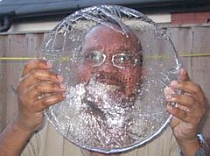Commissioner of Police Guevarro’s statement to the press, delivered shortly after assuming office, is littered with deflective phrasing, institutional buck-passing, and strategic vagueness. This style of public communication—commonly referred to as using weasel words—is not only damaging to public confidence but fundamentally at odds with the standards of public accountability, command responsibility, and constitutional leadership.
1. Abdication of Command Responsibility through Deflection
His repeated assertion that “disciplinary or administrative action... lies solely with the PolSC” is legally correct under section 123 of the Constitution of Trinidad and Tobago. However, the overemphasis on this legal limitation comes across as an attempt to distance himself from the moral and operational responsibility that comes with office.
➤ He is not merely an administrator of reports. He is the Commissioner of Police.
Leadership requires more than notifying the Police Service Commission—it requires taking a firm ethical stance, demonstrating public confidence, and leading by example.
2. Evasive Language Obscuring the Gravity of the Allegations
Guevarro’s phrasing—“certain acts were carried out against him” and “he felt it was bordering on criminal conduct”—is dangerously non-committal. The implication is that this is merely a matter of perception by the complainant (Brent Thomas), rather than a serious allegation of criminal abuse of power by a Deputy Commissioner.
This is institutional gaslighting by omission. When the public is told there is a criminal allegation involving high-ranking officers, clarity is not optional—it is obligatory.
3. The Illusion of Transparency
By repeatedly saying “we are transparent” or “we have nothing to hide,” without actually providing substantive details, the Commissioner engages in rhetorical self-justification rather than accountability.
This is contradicted by:
-
The absence of a timeline for the investigation.
-
The refusal to identify the nature of the allegation.
-
The fact that DCP Martin remains in post despite a potential criminal matter against her.
Transparency is demonstrated by actions, not by repeated verbal affirmations. Saying “we are transparent” is not the same as being transparent.
4. Leadership by Euphemism
The refusal to even name the allegation (widely understood to involve misconduct, unlawful detention, or other abuse of power linked to international legal controversy) is telling. It reinforces the impression that the TTPS lacks the moral courage to confront internal wrongdoing publicly and forthrightly.
Advice to Commissioner Guevarro
As the Commissioner of Police, your office is not merely administrative; it is symbolic. Every word you speak either restores or erodes trust. It is your responsibility to:
-
Speak plainly and truthfully. Avoid legalistic hedging and sanitised language.
-
Affirm command responsibility even where your powers are limited. You may not suspend the DCP, but you can recommend, publicly and forcefully, that she be removed pending investigation.
-
Acknowledge institutional failings instead of hiding behind procedural correctness.
-
Set timelines and report progress regularly to build public trust in the investigation.
The public does not want a bureaucrat. It wants a Commissioner who acts like a leader—not a spokesperson for the system’s evasions.
